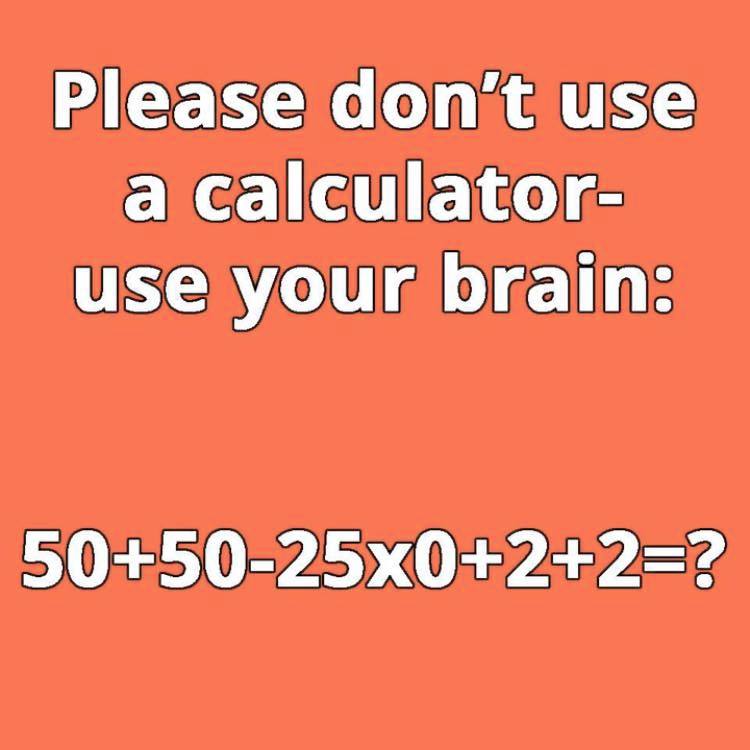Before we jump into solving the equation, it’s crucial to remember the order of operations, often abbreviated as PEMDAS:
- Parentheses
- Exponents
- Multiplication and Division (from left to right)
- Addition and Subtraction (from left to right)
This order is essential because it dictates how we approach solving the equation. Misunderstanding this order can lead to incorrect answers.
Step 1: Identifying Key Operations
Looking at the equation:

Step 2: Solving the Multiplication First
Let’s start by addressing the multiplication:
- 25 x 0 = 0
Multiplying any number by zero gives us zero. This step is crucial because it simplifies the equation significantly. After this, the equation becomes:
50 + 50 – 0 + 2 + 2
Step 3: Simplifying the Equation
With multiplication out of the way, we can focus on the remaining addition and subtraction operations. Since there’s no division or parentheses to worry about, we can proceed from left to right:
- 50 + 50 = 100
- 100 – 0 = 100 (Subtracting zero doesn’t change the value)
- 100 + 2 = 102
- 102 + 2 = 104
Final Answer: The Result
After following the order of operations, the final answer to the equation 50+50-25×0+2+2 is:
104
Why This Problem Is Tricky
At first glance, this equation might look straightforward, but it’s easy to get tripped up if you don’t follow the order of operations carefully. The placement of the multiplication and the presence of zero can lead some to overlook essential steps, resulting in incorrect answers.
Common Mistakes to Avoid
- Ignoring PEMDAS: Some people might add and subtract first, leading to an incorrect total before multiplying by zero.
- Misinterpreting Zero: Multiplying by zero is straightforward, but it’s essential to remember that it only affects the number directly multiplied—not the entire equation.
- Rushing Through the Problem: Because the equation seems simple, it’s tempting to rush. This often leads to overlooking critical steps.
The Importance of Attention to Detail
This problem underscores the importance of attention to detail in math. Even when equations seem simple, missing a single step can lead to a wrong answer. In real-world scenarios, whether in academics or everyday life, understanding and applying the correct order of operations is vital.
Why Mental Math Matters
Practicing problems like this one without a calculator helps sharpen mental math skills. It encourages us to think critically, improves our memory, and boosts confidence in our ability to solve problems on the fly. While calculators are incredibly useful tools, relying on them too heavily can dull these important cognitive abilities.
When to Use a Calculator vs. Mental Math
While it’s great to rely on mental math for problems like this, there are times when using a calculator is more efficient, especially with complex equations or when precision is paramount. However, honing your mental math skills can make everyday calculations quicker and more intuitive, reducing the need for digital assistance.
Teaching the Order of Operations
For educators and parents, this problem is an excellent example of why it’s crucial to teach and reinforce the order of operations early on. It’s a foundational concept in math that students will carry with them throughout their education and into adulthood.
Riddles and Math Puzzles: Fun and Educational
Math riddles and puzzles like this one are not just fun—they’re also an excellent way to learn and reinforce key concepts. They challenge us to think differently, apply what we know, and approach problems systematically. Whether used in classrooms or as brain teasers at home, these puzzles make learning engaging and memorable.
Conclusion: The Power of Problem-Solving
In conclusion, the math problem 50+50-25×0+2+2 might seem simple at first glance, but it’s a great example of why following the order of operations is so important. By carefully breaking down the problem and solving it step by step, we arrive at the correct answer: 104. This exercise reminds us of the value of attention to detail, the importance of mental math, and the joy of solving problems with our own intelligence. So next time you encounter a similar puzzle, take your time, trust your skills, and enjoy the process of finding the solution!





